Best Gothic Spring : Dramatic Elements with Fresh Spring Updates
There’s something magical about the transition from winter’s embrace to the renewal of spring. As I pack away my heavy winter decor, I’m drawn to keeping that moody, dramatic aesthetic I love while welcoming the season’s rebirth. That’s why Gothic Spring has become my favorite design approach—it marries dark, dramatic elements with fresh, seasonal touches for a uniquely enchanting home.
I’ve always been drawn to gothic aesthetics. The rich history, architectural drama, and touch of mystery speak to me on a deeper level than bright, airy spaces ever could. But that doesn’t mean I can’t celebrate spring! In fact, the contrast between gothic elements and spring’s renewal creates a captivating tension in home design that feels both grounded and uplifting.
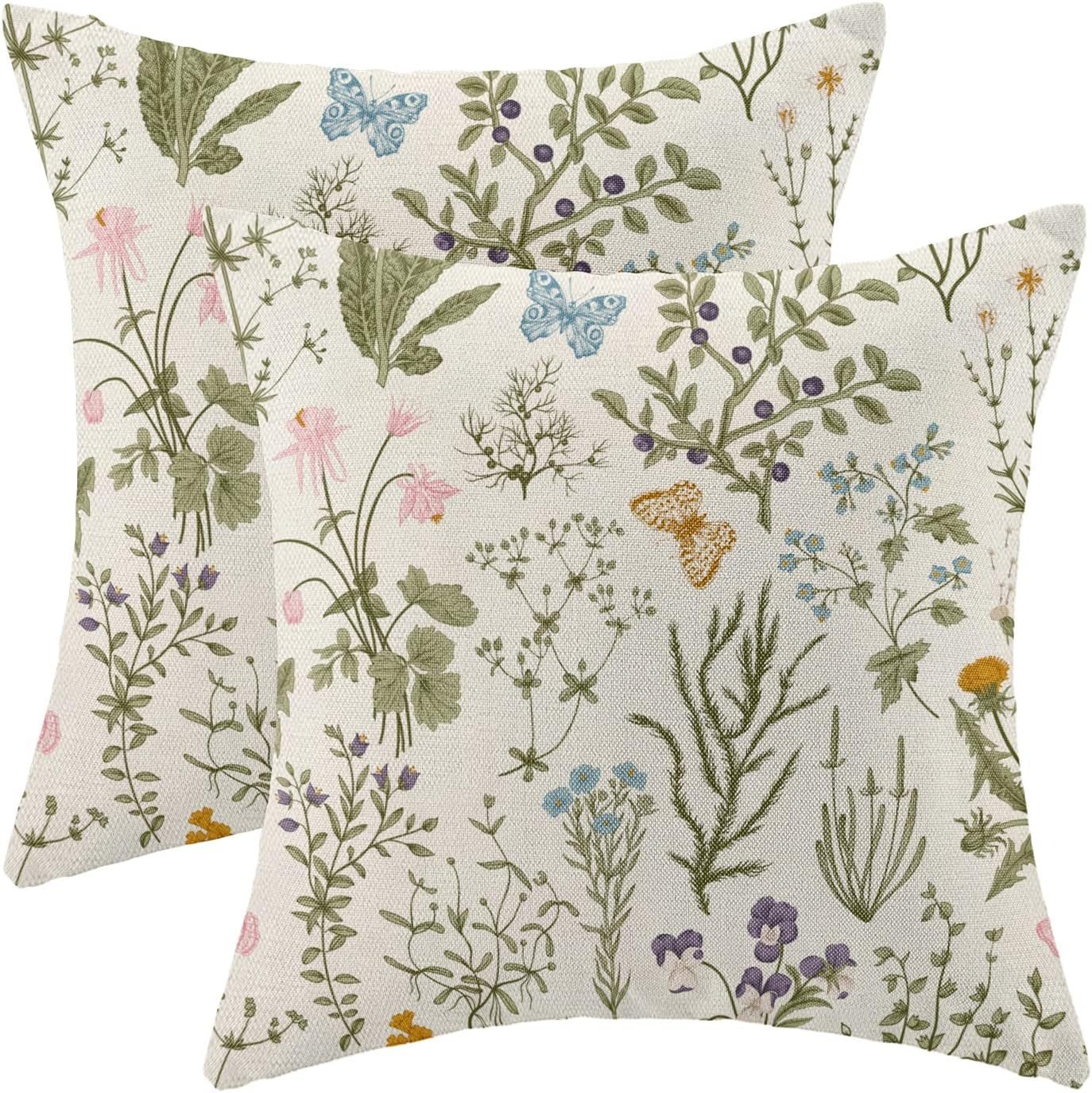



What Exactly Is Gothic Spring Design?
Gothic Spring isn’t about recreating a medieval cathedral in your living room (though architectural elements certainly play a part). Instead, it’s about maintaining the moody foundation of gothic design—dark colors, dramatic silhouettes, ornate details—while incorporating fresh seasonal elements that breathe new life into the space.
The result? Rooms that maintain their dark, dramatic soul while acknowledging spring’s renewal through carefully chosen accents, textures, and natural elements. It’s the perfect compromise for those of us who love the dark and dramatic but still want to celebrate the changing seasons.
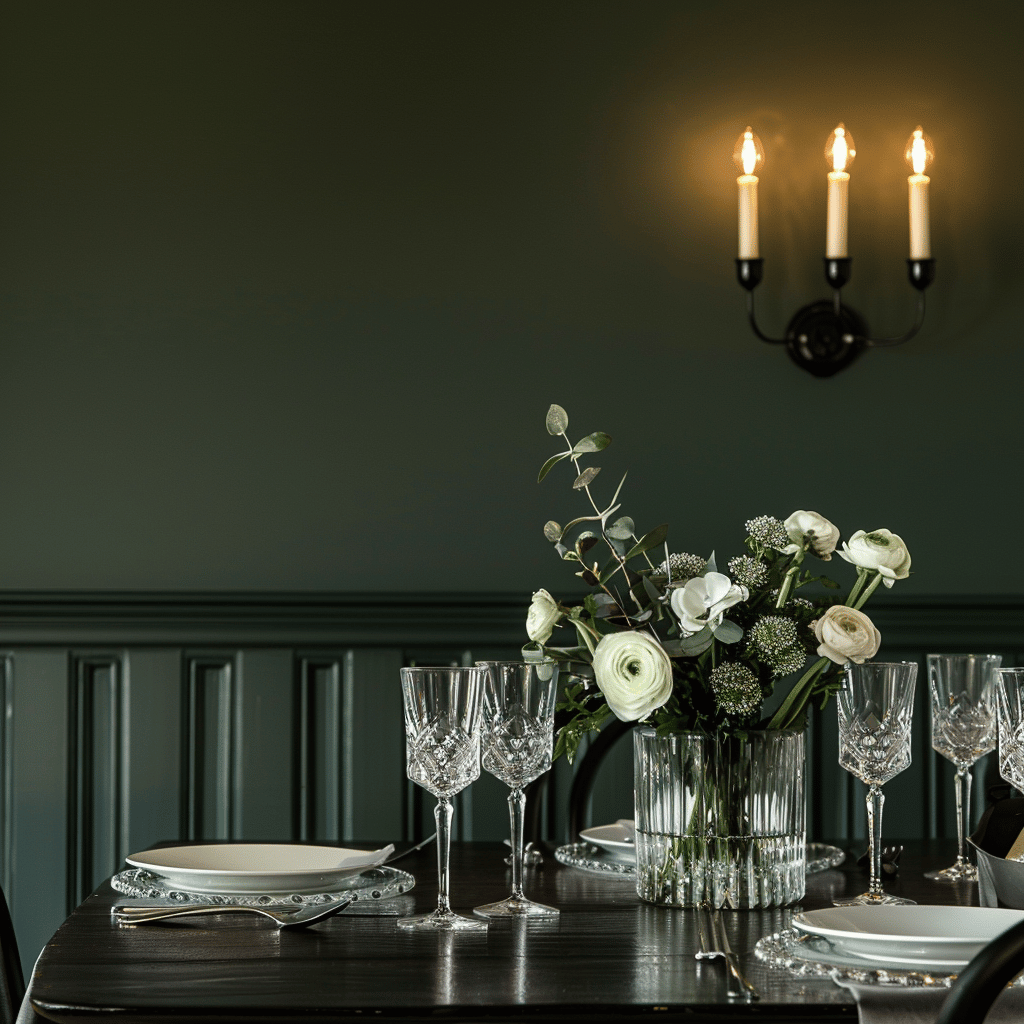
The Foundation: Core Gothic Elements
Before we talk about spring updates, let’s understand the gothic design elements that form our foundation:
1. Dark, Moody Color Palette
The backbone of gothic design is a rich, deep color palette. Think charcoal grays, midnight blues, deep purples, and of course, black. These colors create the perfect canvas for our spring additions to stand out. In my own home, I’ve painted my living room walls a deep navy that makes everything else pop with intention.
When people visit, they often ask if dark walls make the space feel smaller. In my experience, it’s quite the opposite. Dark walls recede, creating depth that makes the room feel almost infinite in the evening hours. They also provide incredible drama that no light wall could ever deliver.

2. Architectural Details
Gothic design celebrates architectural elements—arched doorways, ceiling medallions, ornate moldings, and pointed details. If you’re lucky enough to have these features in your home, highlight them. If not, consider adding architectural details through furniture or decor.
Last year, I installed picture frame molding on my bedroom wall, painted it all black, and was amazed at how this simple addition completely transformed the room’s character. The shadows cast by the molding throughout the day create an ever-changing display that adds tremendous visual interest.
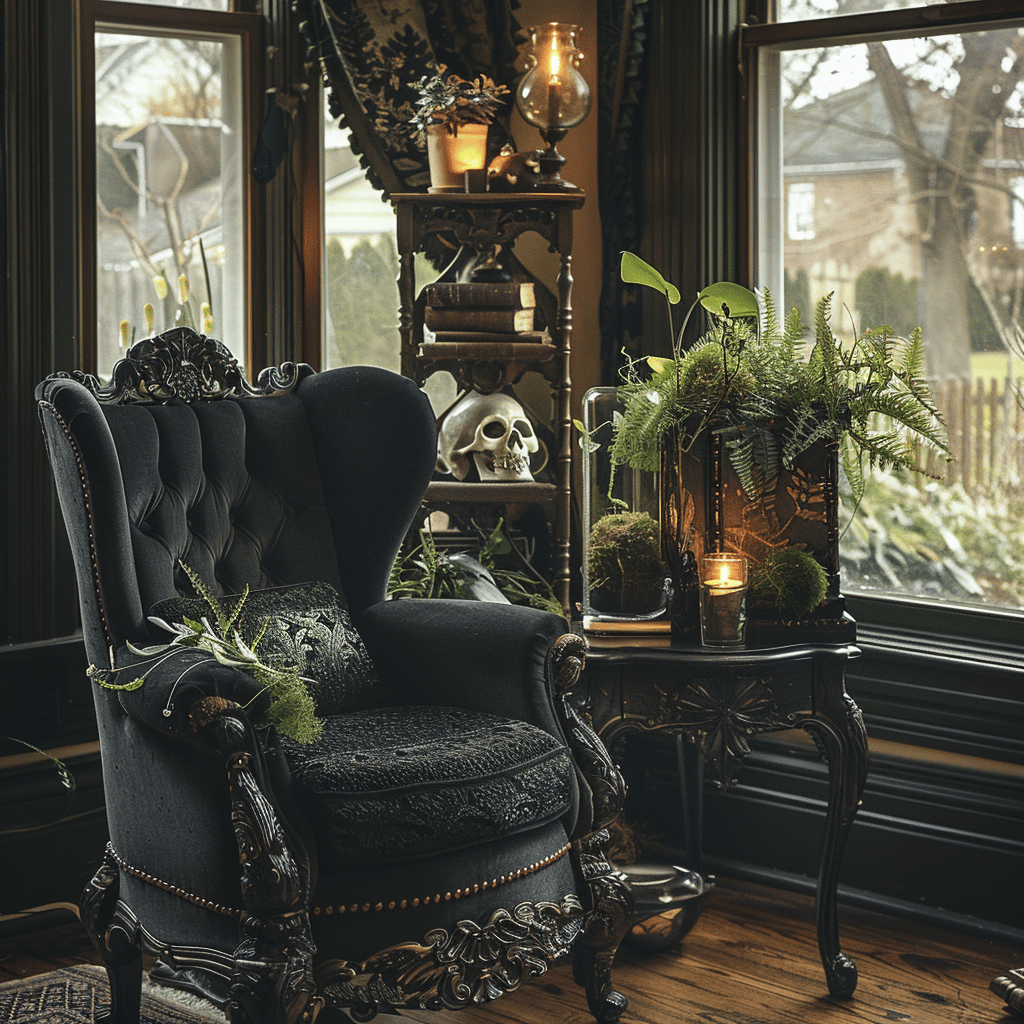
3. Ornate Furniture
Gothic-inspired furniture tends to feature ornate detailing, dark woods, and sometimes dramatic silhouettes. Carved details, velvet upholstery, and substantial pieces ground your space in gothic tradition.
My vintage mahogany sideboard with its intricate carvings is perhaps my favorite piece. While many would sand and paint such a piece white, I’ve embraced its deep, rich tone and ornate character. It serves as an anchor in my dining room, providing both beauty and functionality.
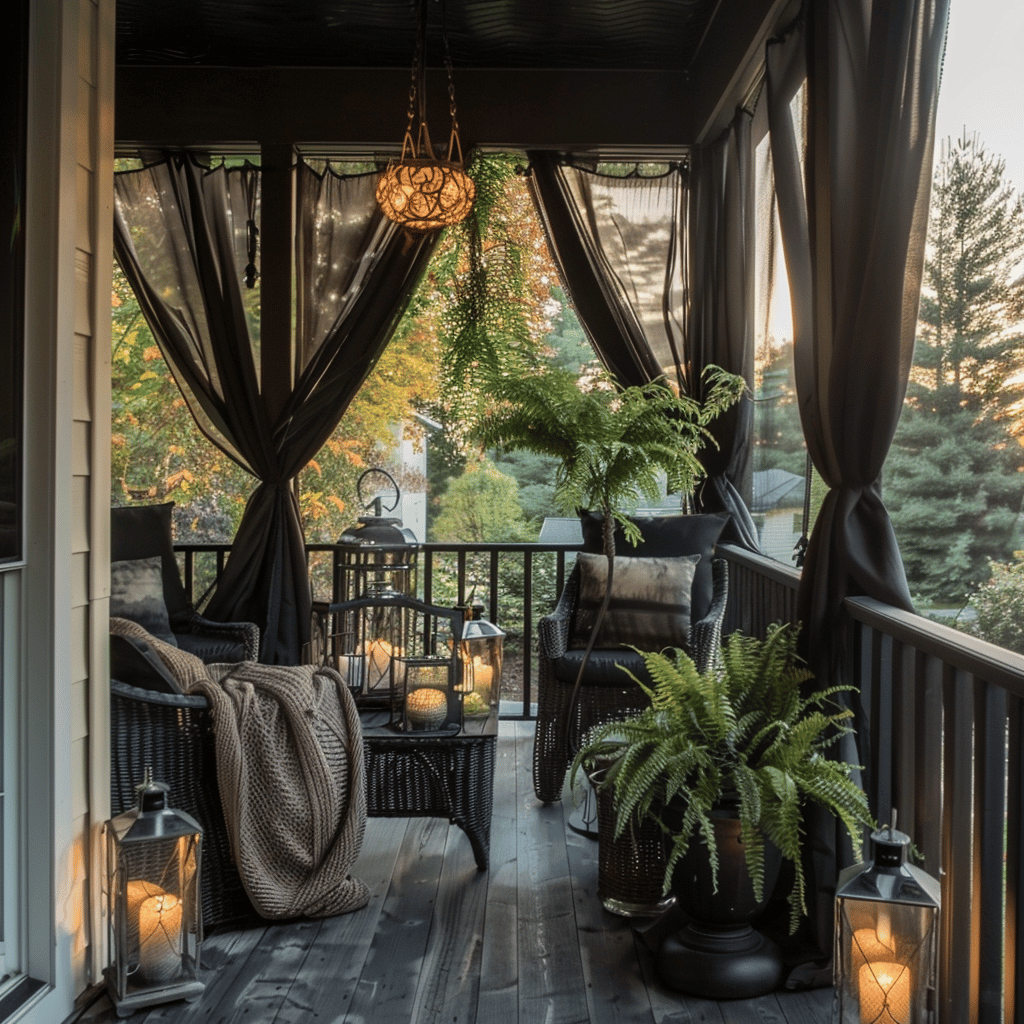
4. Dramatic Lighting
Gothic spaces embrace the interplay of light and shadow. Ornate chandeliers, wall sconces, and candelabras create ambient lighting that enhances the mysterious atmosphere. In my home, I’ve installed dimmers on nearly every light switch, allowing me to control the mood with precision.
There’s something magical about a gothic-inspired space in the evening hours—shadows dancing across ornate details, candles flickering to create depth, and strategic lighting highlighting architectural features. It’s atmospheric in a way bright, overhead lighting never achieves.

Spring Renewal: Seasonal Updates for Gothic Spaces
Now for the exciting part—how to infuse spring’s rebirth into your gothic foundation:
1. Botanical Elements with a Gothic Twist
Spring calls for florals, but gothic spring demands something more interesting than cheerful daisies. Consider:
- Dark Florals: Arrangements featuring deep purple irises, black dahlias, or darker greenery
- Dried Botanical Elements: Preserved flowers, dried grasses, and seed pods
- Unusual Specimens: Carnivorous plants, unique ferns, or plants with dramatic shapes
- Gothic Vessels: Display flowers in ornate silver, black ceramic, or antique brass containers
My dining table currently features a dramatic arrangement of dark purple calla lilies and black mondo grass in a tarnished silver compote. The effect is hauntingly beautiful—celebrating spring’s renewal while maintaining the gothic aesthetic I love.
2. Textural Contrasts
Gothic design often incorporates rich, heavy textures like velvet and brocade. For spring, introduce contrasting lighter textures while maintaining your color palette:
- Linen: Replace heavy winter drapes with linen ones in your dark color palette
- Gauzy Fabrics: Layer sheer black or deep purple fabrics over windows
- Natural Fibers: Introduce jute, sisal, or sea grass in dark tones
- Lighter Throws: Swap winter’s heavy blankets for lighter cotton or linen versions
In my own bedroom, I’ve exchanged my heavy velvet duvet cover for a lightweight black linen one. It maintains the dark aesthetic while feeling appropriate for warmer spring evenings.
3. Reflective Surfaces
Spring is about light, and even gothic spaces can celebrate this with strategic use of reflective elements:
- Mirrors with Ornate Frames: Amplify natural light while maintaining gothic character
- Mercury Glass: Adds a mysterious shimmer to tablescapes
- Crystal Elements: Catch and scatter light in unexpected ways
- Metallic Accents: Silver, brass, or copper details add subtle gleam
My favorite spring addition is a collection of antique mercury glass vessels arranged on my mantel. They capture and reflect light in a way that feels magical yet perfectly aligned with the gothic aesthetic.
4. Nature-Inspired Motifs
Gothic design already celebrates nature through carved elements and motifs. Emphasize these for spring:
- Bird Motifs: Ravens, crows, or ornate songbirds add spring spirit with gothic flair
- Butterfly Specimens: Framed butterflies or moths combine natural history with gothic sensibility
- Botanical Prints: Vintage illustrations of plants, especially unusual specimens
- Animal Elements: Antlers, skulls, or taxidermy (ethically sourced) connect to nature’s cycles
My latest addition is a series of framed 19th-century botanical prints featuring poisonous plants. They’re scientifically accurate, beautifully rendered, and add the perfect touch of natural history to my study walls.
5. Sensory Elements
Spring engages all senses—incorporate this multisensory approach in your gothic space:
- Scent: Replace heavy winter fragrances with lighter options like herb gardens, floral incense, or rain-scented candles
- Sound: Open windows to hear birds, wind chimes with deep tones, or nature soundscapes
- Touch: Introduce contrasting textures that invite interaction
- Taste: Display seasonal dark fruits like blackberries or plums in ornate bowls
In my kitchen, I’ve started an herb garden in a collection of black ceramic pots. The fresh scent of herbs combines with their textural quality to bring spring’s renewal indoors while maintaining my aesthetic preferences.
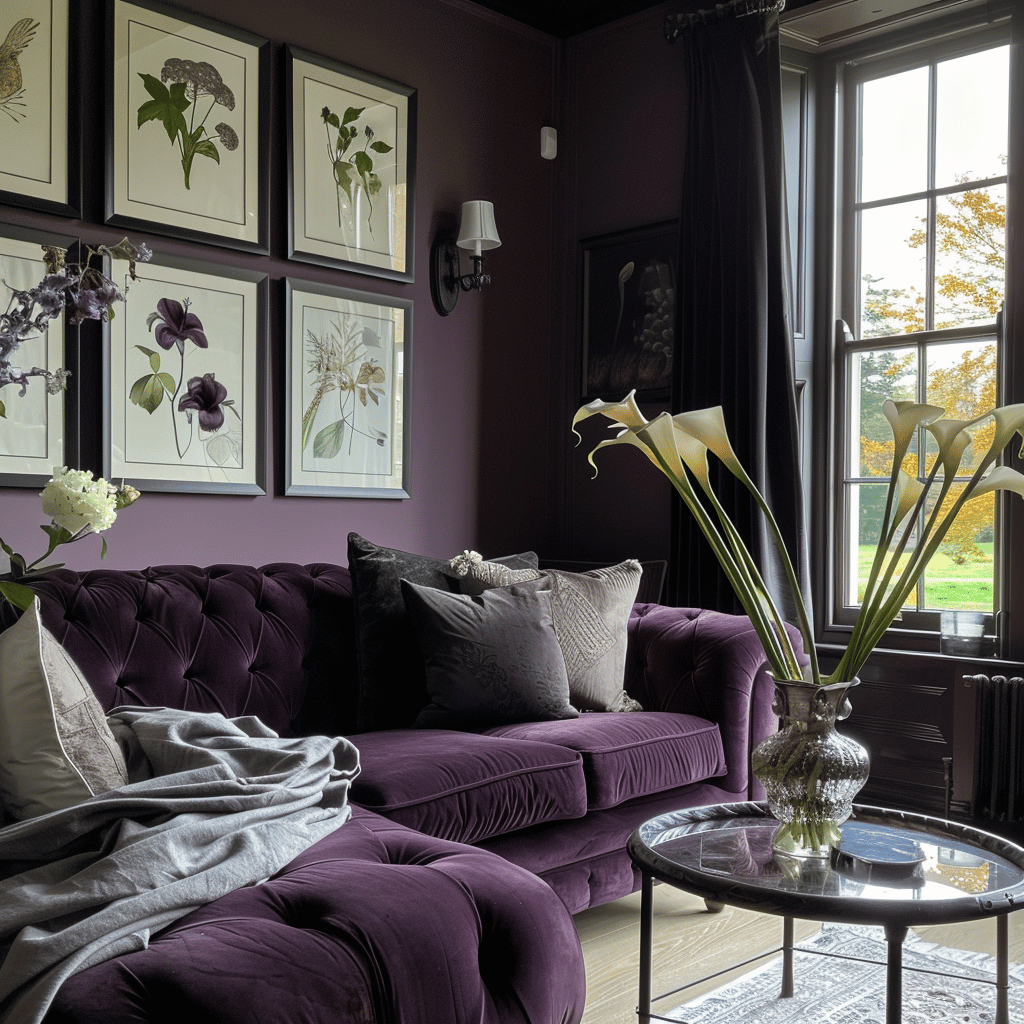
Room-by-Room Gothic Spring Updates
Let’s explore how to apply these principles throughout your home:
Living Room
The living room offers countless opportunities for gothic spring expression:
- Replace heavy curtains with lighter fabrics in your dark palette
- Introduce botanical elements in ornate vessels
- Swap out heavy throw blankets for lighter versions
- Add reflective elements to capture spring’s increasing light
- Incorporate botanical prints or nature illustrations
In my own living room, I’ve maintained my black velvet sofa and dark walls but lightened the space with sheer charcoal curtains that dance in spring breezes. A large arrangement of branches with new spring growth in a tarnished silver urn brings the outside awakening in.
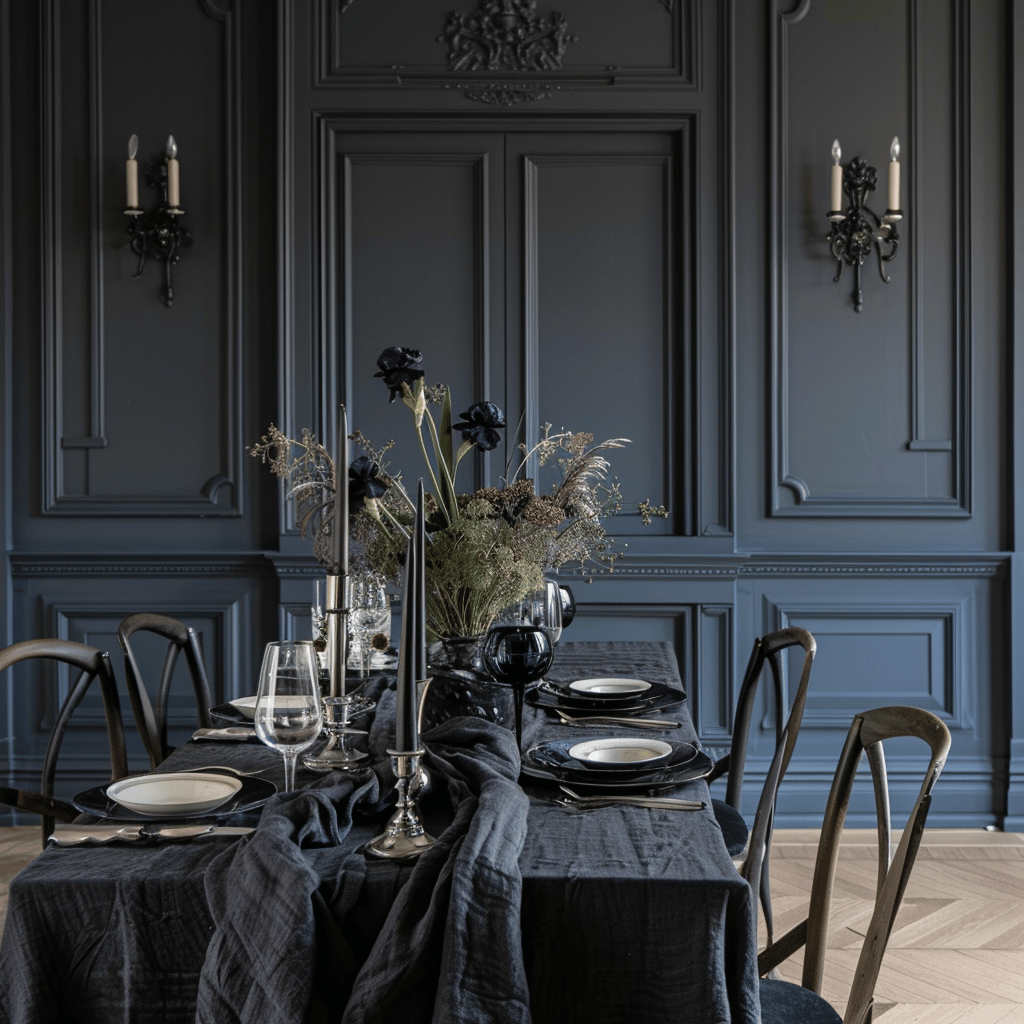
Dining Room
The dining area provides a perfect canvas for seasonal tablescapes:
- Create a centerpiece with dark florals or unusual botanical elements
- Use lighter table linens in your gothic color palette
- Introduce mercury glass or crystal elements that play with light
- Display seasonal fruits in ornate bowls
- Add taper candles in interesting holders for evening ambiance
My spring dining table features black linen placemats, tarnished silver candlesticks, and those dramatic calla lilies I mentioned earlier. For dinner parties, I’ve added individual sprigs of fresh herbs at each place setting—a small touch of spring that guests can interact with through sight, touch, and scent.
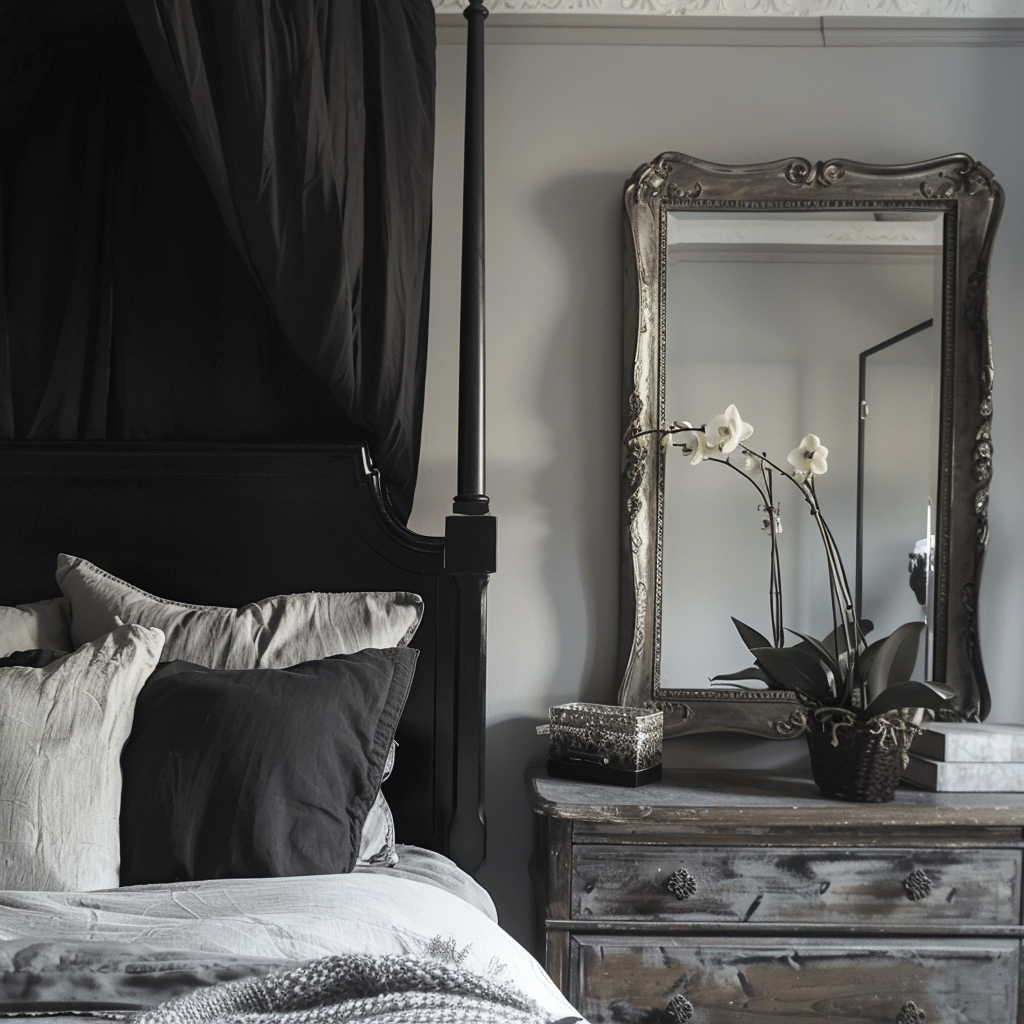
Bedroom
Your bedroom can maintain its gothic sanctuary feeling while acknowledging the season:
- Switch to lighter bedding in your dark palette
- Add botanical elements in unique vessels
- Replace heavy curtains with lighter options
- Introduce natural textures through bedside rugs or throws
- Incorporate reflective elements to capture morning light
My bedroom’s black walls remain, but I’ve lightened the space with charcoal linen bedding, sheer black curtains that catch the breeze, and a collection of small mirrors in ornate frames that scatter morning light across the ceiling.
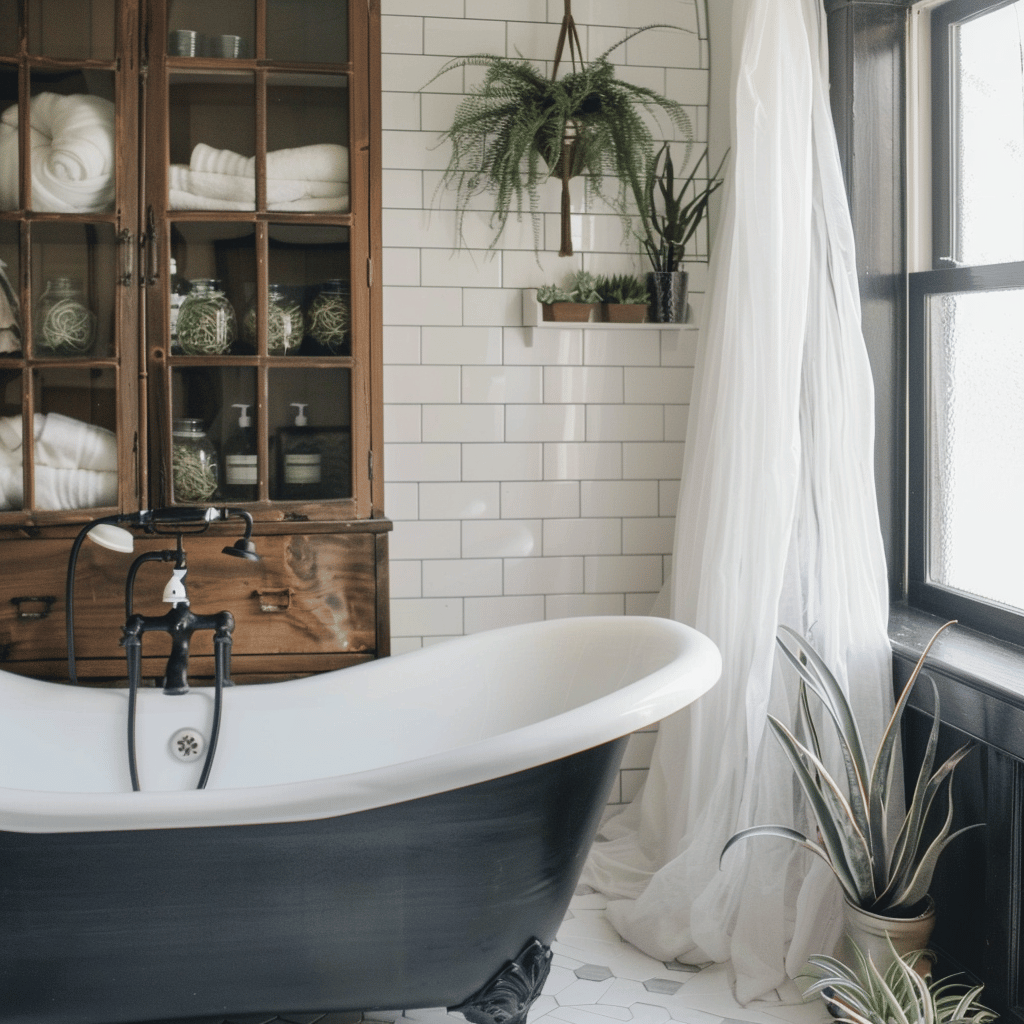
Bathroom
Even utilitarian spaces deserve seasonal attention:
- Add dark florals in unique containers
- Display artisanal soaps with spring scents on ornate dishes
- Hang botanical prints in weathered frames
- Introduce plants that thrive in humid environments
- Use lighter, gauzy shower curtains in dark colors
My bathroom features a collection of air plants in glass orbs suspended at different heights—their unusual forms and ability to live without soil make them perfectly suited to a gothic spring aesthetic.
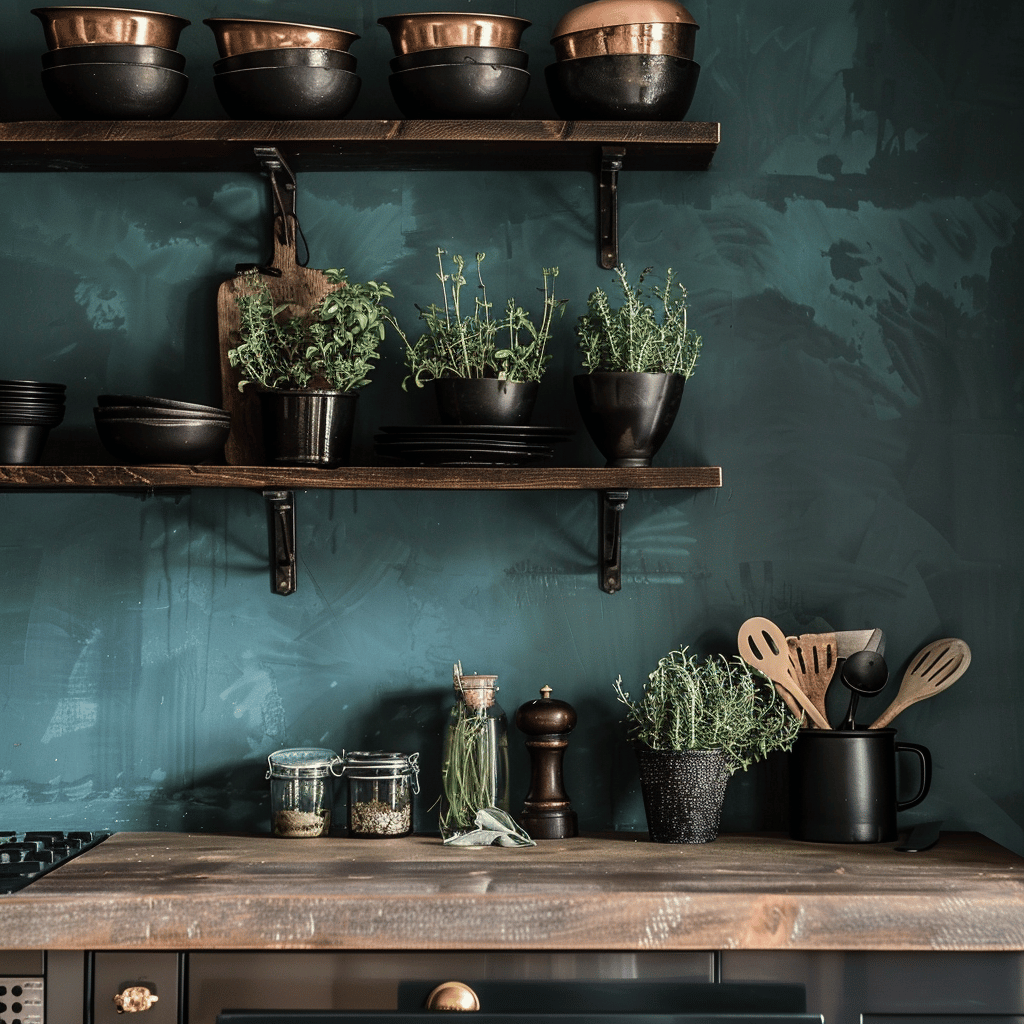
Finding Your Gothic Spring Balance
The key to successful Gothic Spring design is balance. You’re creating tension between seemingly opposing elements—dark and light, heavy and ethereal, mysterious and renewing. This creative tension makes gothic spring spaces so compelling.
As you implement these ideas, remember there’s no formula—it’s about finding what speaks to you. Perhaps you’ll lean more gothic with just hints of spring, or maybe you’ll embrace more seasonal elements while maintaining your gothic foundation.
In my home, each room strikes a slightly different balance. My office remains heavily gothic with minimal spring touches, while my sunroom embraces more seasonal elements while maintaining gothic underpinnings through color and architectural details.
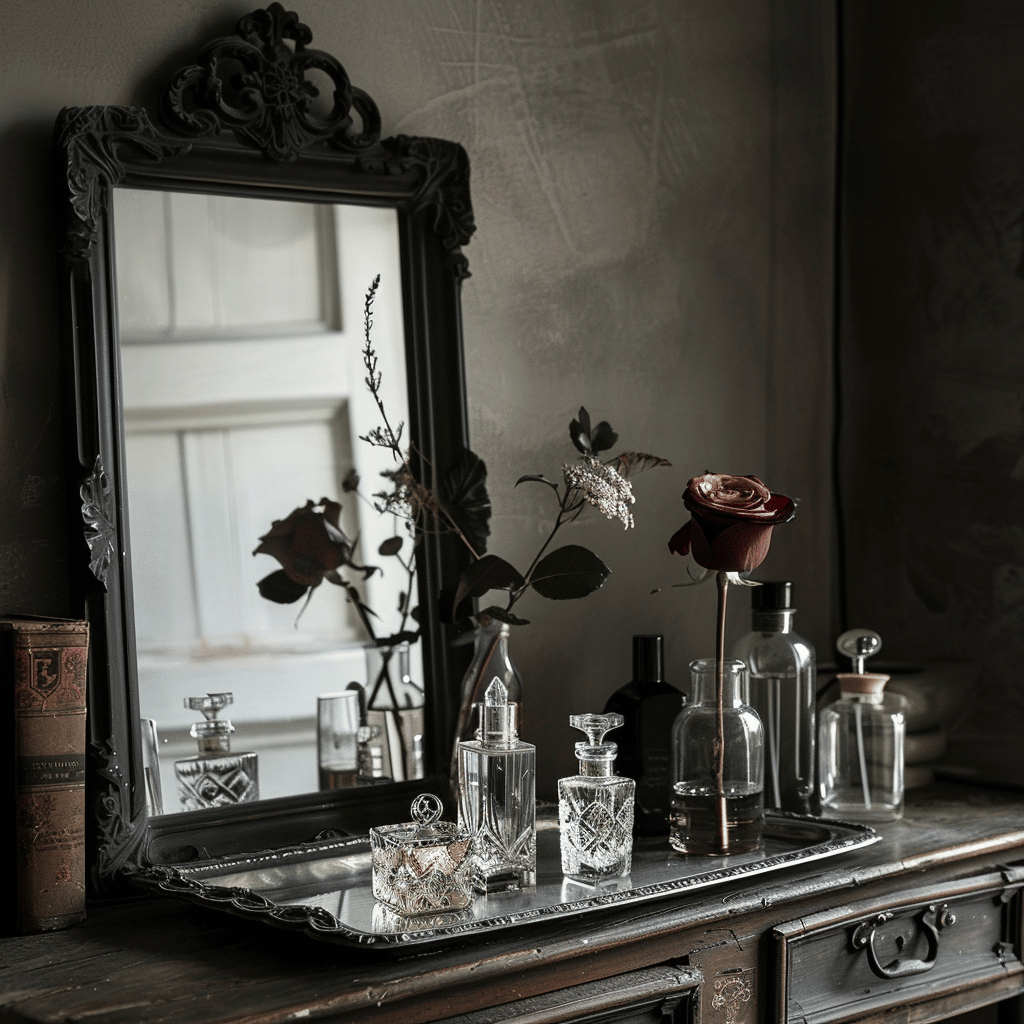
Embracing Imperfection
One final thought about Gothic Spring design—it celebrates imperfection and the patina of age. Tarnished metals, weathered woods, and faded textiles all tell stories of time’s passage. This embrace of imperfection aligns beautifully with spring’s message of renewal amid life’s cycles.
Don’t be afraid of pieces that show their age or bear marks of their history. In my home, a weathered black sideboard with peeling paint holds pride of place in my entryway. Its imperfections make it more interesting and authentic than any new piece could ever be.

Final Thoughts: Your Gothic Spring Journey
As I look around my home today, I’m struck by how this design approach has evolved over years of experimentation. My Gothic Spring aesthetic feels deeply personal—a reflection of my appreciation for history, drama, and nature’s cycles.
I encourage you to approach your own Gothic Spring journey with openness and creativity. There are no rules here—only the opportunity to create spaces that honor both your love of the dramatic and the undeniable hope that spring brings.
Remember that your home should tell your story. If that story includes both gothic drama and spring’s renewal, you’ve found your design home in Gothic Spring. Embrace the beautiful contradiction and watch your spaces come alive with newfound depth and meaning.
What gothic elements will you keep? What spring touches will you add? The answers will be as unique as you are—and that’s exactly as it should be.
If you love home decor and interior design as much as I do, check out these other articles I think you might like.
Maximalist Spring : Bold Patterns and Layered Spring Decor

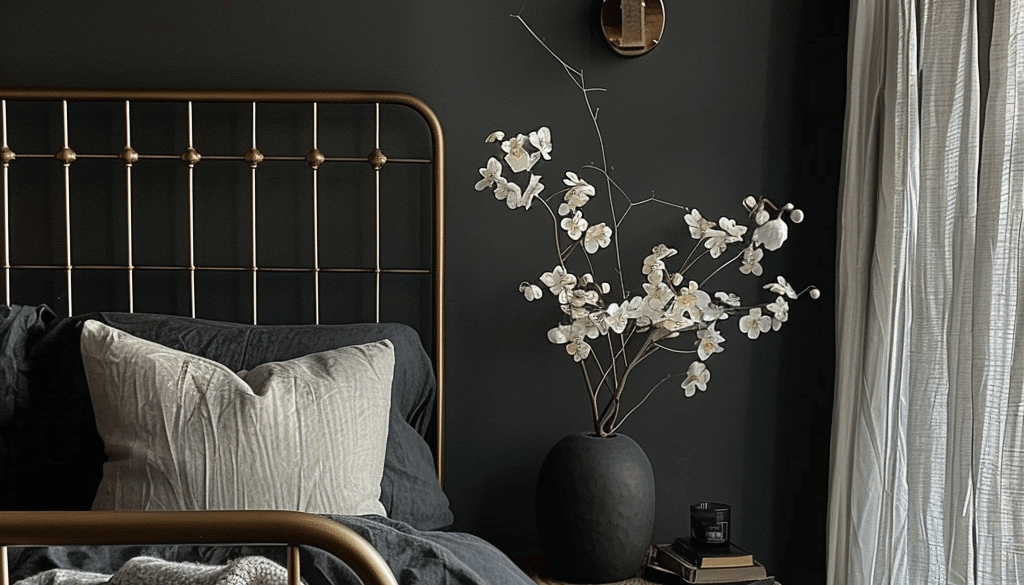
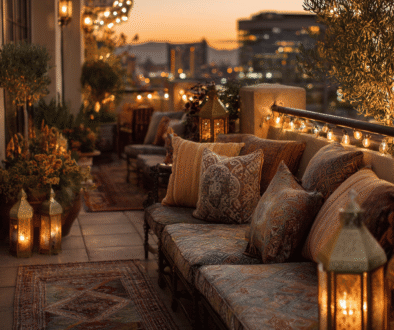
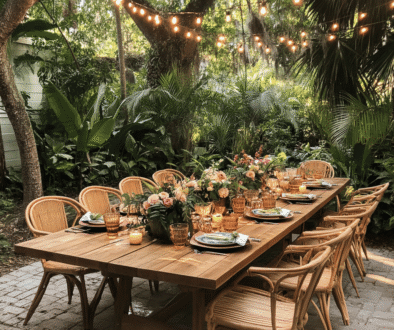

Brutalist Spring Softening Raw Concrete with Spring Elements
April 23, 2025 @ 12:43 pm
[…] Gothic Spring : Dramatic Elements with Fresh Spring Updates […]
Light Academia Spring : Soft, Intellectual Spring Styling
April 25, 2025 @ 12:10 pm
[…] Gothic Spring : Dramatic Elements with Fresh Spring Updates […]